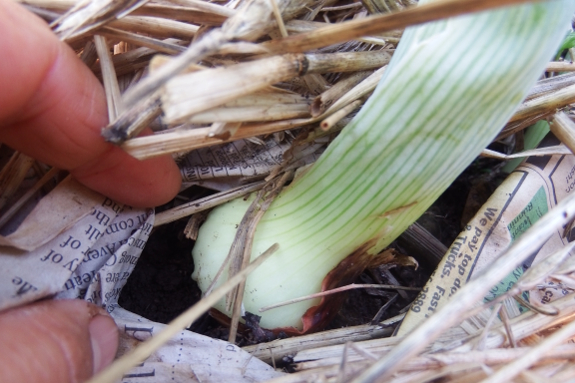
archives for 06/2016
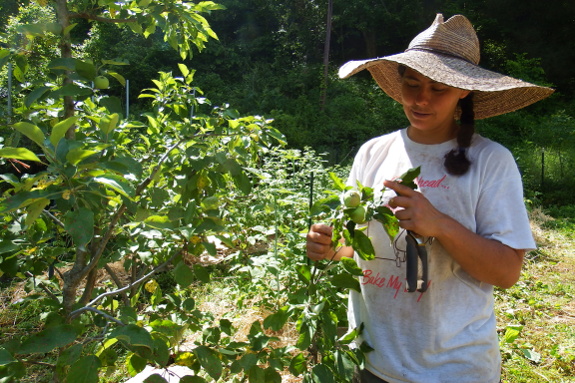
I'm learning more and
more about apple pruning with each year that goes by. This week, for
example, I learned the hard way not to prune bearing trees while
wearing a hat. Yep, that peripheral vision is essential to prevent me
from cutting off baby fruits!
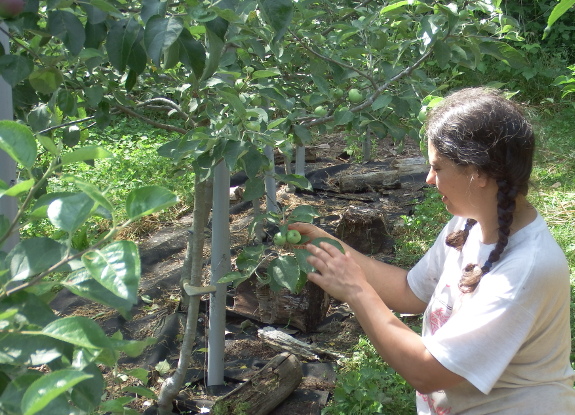
More seriously, I'm also
starting to fully understand some of the high-density
apple pruning advice
that I'd been merely following by rote in previous years. For example,
I'd broken the rules and let my limbs get a little longer than is
recommended. But now I realize that those longer limbs are going to be
in danger of breaking under the weight of developing fruits! For this
year, I'll depend on Mark's careful touch to tie them up without losing
the apples, but wherever I can I'm not whacking back limbs so they end
much closer to the main trunk.
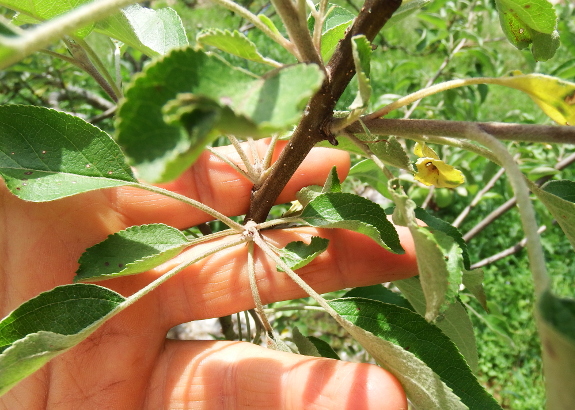
I also had a minor
epiphany that relates to Michael
Phillips' comment that apple trees decide whether a spot is going
to fruit or not in June of the previous year. "How does he know that?"
I thought while reading his excellent book. Now I realize he simply
used his eyes.
Yep, those two clusters of leaves atop my fingers are flower spurs
while the next two buds up the branch turned into vegetative growth
(new long stems). In my high-density grove, I'm whacking back long
stems just past the new flower spurs to keep next year's fruits while
preventing the gangly limb sydrome I mentioned previously.
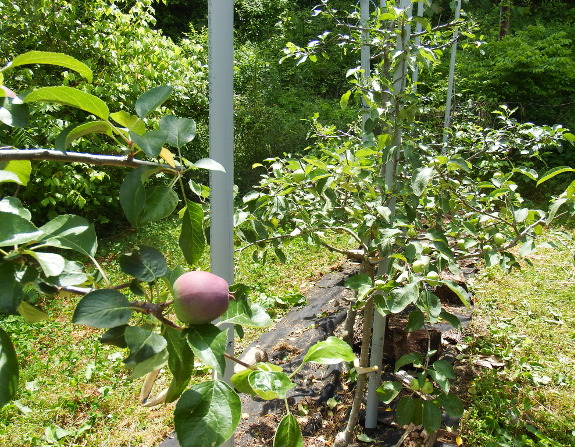
Here's our oldest
high-density row post-pruning. I'll admit that the trees do look pretty shorn. But
hopefully that severe summer pruning will keep the trees small and
productive so we wind up with even more apples next year.
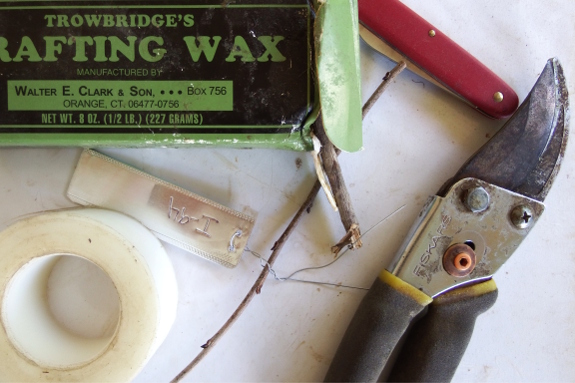
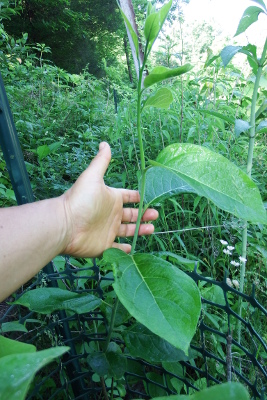 Of the two American
persimmon grafts that took last year, one is puttering along very
slowly while the other has exploded (see photo to the left). The
scionwood on this variety is I-94, and despite the less than inspiring
name the plant made enough growth for me to cut a bit of scionwood last
winter. (Yes, all of the new greenery in the photo grew post-trimming.)
Of the two American
persimmon grafts that took last year, one is puttering along very
slowly while the other has exploded (see photo to the left). The
scionwood on this variety is I-94, and despite the less than inspiring
name the plant made enough growth for me to cut a bit of scionwood last
winter. (Yes, all of the new greenery in the photo grew post-trimming.)
Rewinding back to the
winter, I stuck the scionwood in the fridge in a ziploc bag to wait for
persimmon-grafting season --- late May to early June when the rootstock
plants are vigorously growing. Then I pulled out my shears and knife
and turned two more seedling trees into a named variety.
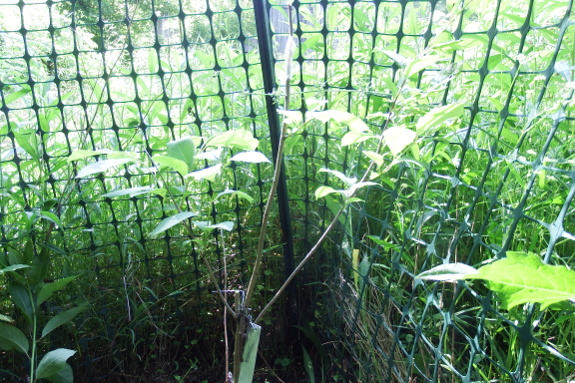
I have to admit that I'm
not convinced this year's grafts will take. The scionwood was on the
small side and it dried out a bit in the fridge despite its bag. But
there's no reason not to try. And, if all else fails, I should be able
to get some excellent scionwood off that I-94 plant this coming winter
for 2017 grafting.
Tomato plants are doing so well they already needed the first round of pruning.
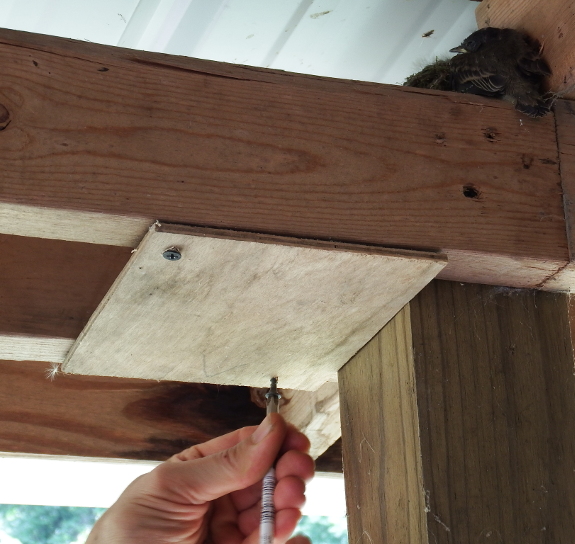
The good news is, Mama Phoebe
fledged five babies. Pretty impressive!
The bad news is, when
those babies started hopping out of the nest for their couple of days
on the ground learning to fly, Huckleberry started picking them off the
way I gorge on ripe strawberries.
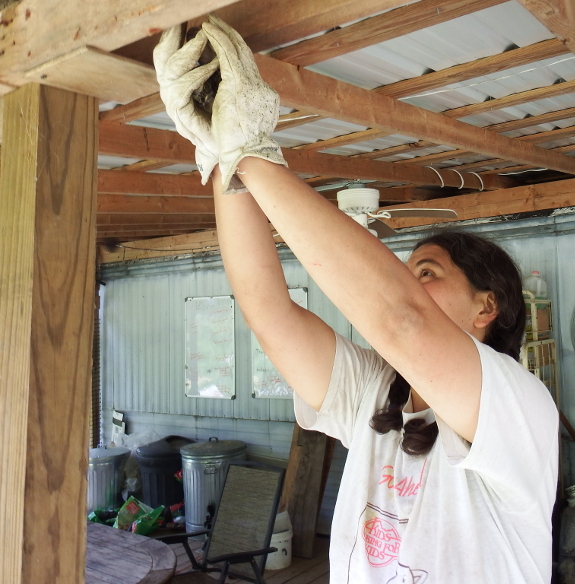
When we found the first
baby on the ground, Mark installed a little porch beneath the nest to
let the overflow spill out onto. We figured maybe that baby had simply
fallen out of the nest because the receptacle was way too small to hold
all those growing birds. After reading a snopes article debunking the
notion that birds can smell human on returned babies, I put the dropped
fledgling back up high.
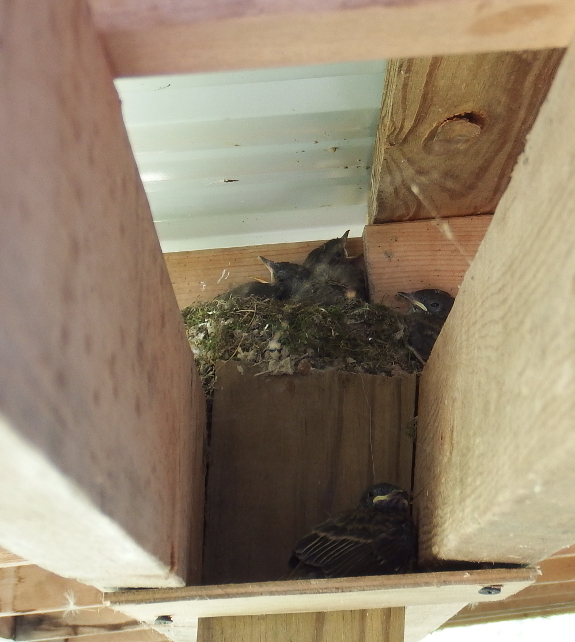
That worked fine until
the rest of the fledglings tried to learn to fly...and ended up right
in Huckleberry's jaws. I know for a fact he got two of the babies and
have a sinking suspicion he might have tracked down yet more.
As much as I enjoyed
watching the phoebe life cycle up close and personal, I'm hoping Mama
Bird learned her lesson and will return to nesting in the barn next
year. It's just safer there.
June is firewood month for us.
Our Stihl 039 does not want to idle properly.
I'm hoping a new spark plug helps the situation.
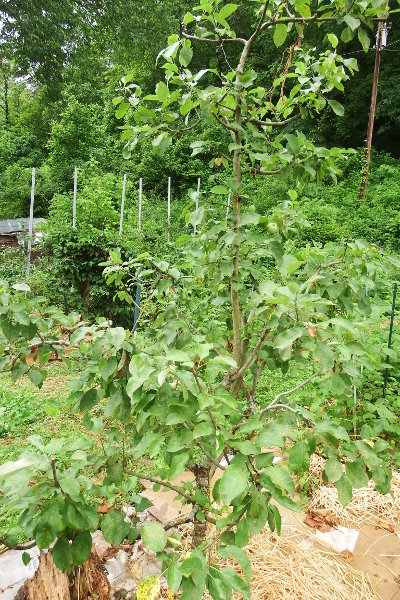 "Anna, you two seem to put so
much effort into your highly managed orchard plot. What are the
advantages of that effort vs just letting apple trees grow without
interference?" --- doc
"Anna, you two seem to put so
much effort into your highly managed orchard plot. What are the
advantages of that effort vs just letting apple trees grow without
interference?" --- doc
The advantages are more
fruit faster, or at least so the theory goes. I'm too early in the
experimentation process to say for sure whether it's working, but early
results seem positive.
For example, take a look
at the two trees in this post. Both are early transparent apples (aka
yellow transparents). Both are on dwarfing rootstock.
The one illustrated in the top picture was planted in February 2009 and
pruned using standard, minimal winter-pruning techniques. It seemed so
averse to fruiting that I considered ripping it out a couple of years
ago, but instead changed it over to a
crazy looping method that I slowly morphed into my usual high-density
training method. And this year, we finally have fruit on the
limbs...although only seven apples over the whole rather large tree.
 In contrast, the second tree
(same variety, same rootstock) was planted in late 2012 (so four growth
seasons later). It's currently loaded with apples (36) and would have
fruited last year too if we hadn't experienced a deep freeze.
In contrast, the second tree
(same variety, same rootstock) was planted in late 2012 (so four growth
seasons later). It's currently loaded with apples (36) and would have
fruited last year too if we hadn't experienced a deep freeze.
I know many people enjoy
the low-work approach and point to mature, standard apple trees that
bear well with minimal pruning and training. The trouble is, those
trees are humongous (one would take up a quarter of my garden) and they
might not fruit for over a decade. A little extra work --- about 2
hours per month for all of our fruit trees combined --- really does
seem worth a greater variety and volume of apples now rather than
waiting until I'm completely gray to taste the first bite.
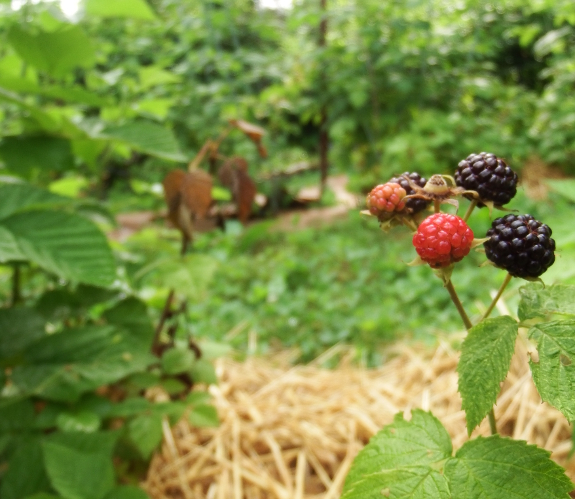
Strawberries will end soon and these berries will make a good replacement.
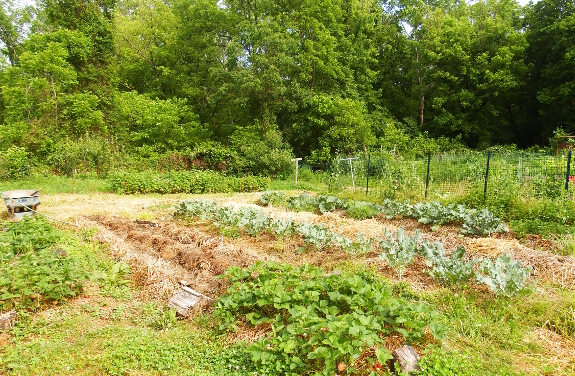
I always plan to
maintain the garden by zones...but I get behind and have to spend the
rest of the summer rushing around to catch up. This year, I've (mostly)
managed the task by (mostly) planting cohorts of vegetables in the same
area each week.
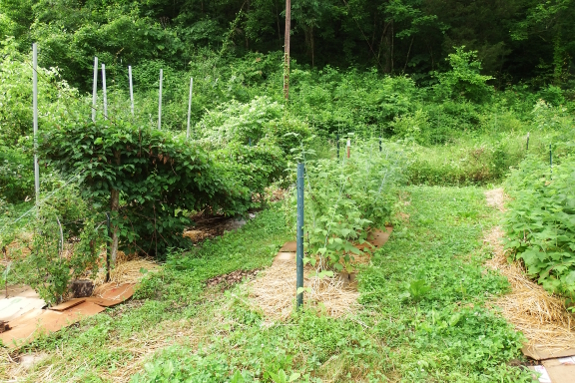
The benefit is profound
--- full areas like the one shown above that are weeded, mulched, and
pruned all at the same time. There's nothing quite like walking by a
row of fruit on the way to the composting
toilet every day and knowing there's nothing that needs to be done
in that zone...except enjoy the first black raspberries.
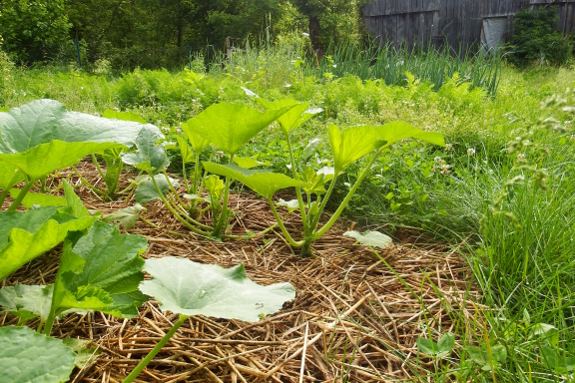
Of course, the downside
of zone gardening is that each area looks pretty shaggy by the time I
get back to it. I had to zoom way in on the mule garden to make it look
at all attractive --- from a distance, the area is simply a sea of
green.
On the plus side, the mule garden is pretty much all that's on my list
for next week. So I should have it back shipshape in no time.
We are one year into our 12 year weed barrier life span.
It looks like it really might last another decade.
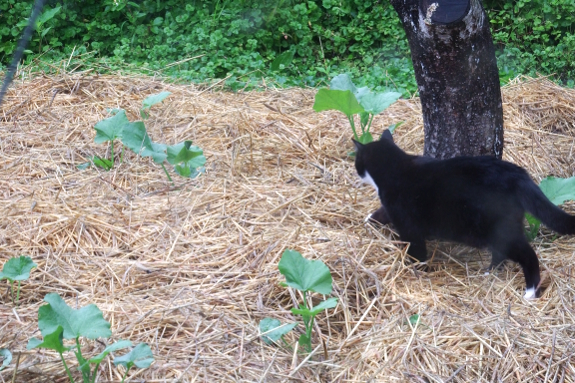
Perception: My fancy,
hybrid butternut seeds didn't germinate very well.
Test: I checked the
packet to see how many seeds I planted --- 30. Then I counted how may
seedlings had come up --- 24.
Reality: 80% germination
in a wild, garden setting isn't bad at all. I did replant the gaps with
saved, unfancy butternut seeds though. Gotta have plenty of our goats'
favorite concentrate!
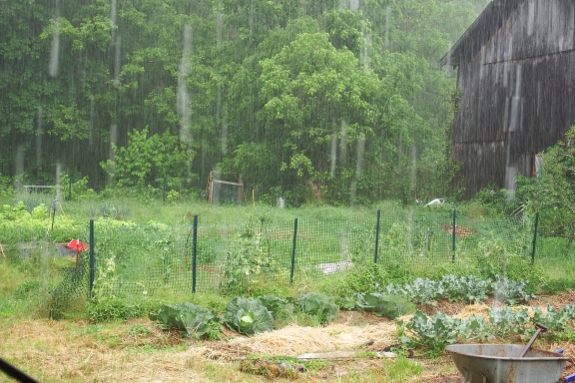
We won't need to water the garden for a little while.
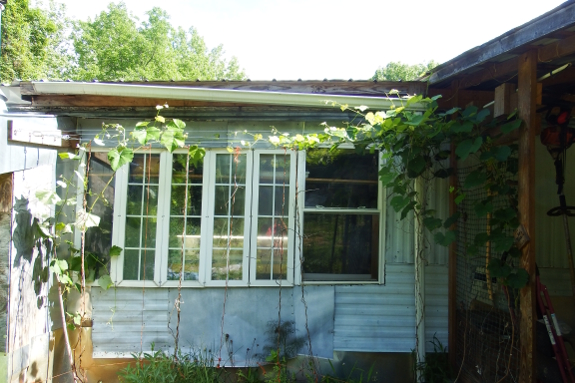
Our shade
trellis is starting
to fill in. Yes, this is the beginning of the grapes' third season of
life --- they're done sleeping and creeping and are ready for leaping.
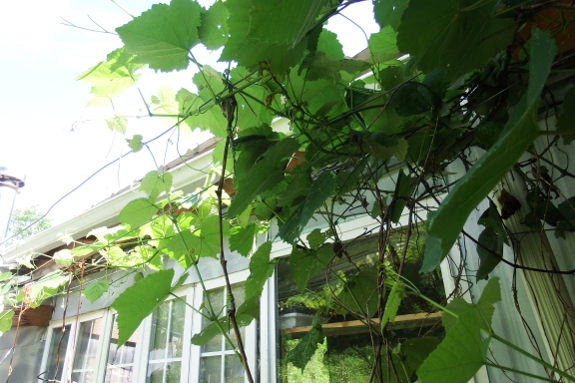
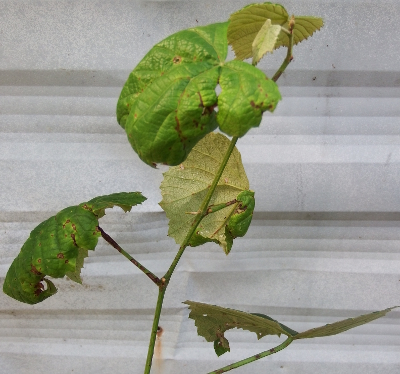 Some combination of sunny
microclimate and good variety selection (Reliance) have resulted in
vines that do much better than any of our grapes have in the past. But
there is still some phomopsis
trying to rear its ugly head.
Some combination of sunny
microclimate and good variety selection (Reliance) have resulted in
vines that do much better than any of our grapes have in the past. But
there is still some phomopsis
trying to rear its ugly head.
This week, I pruned hard
in hopes of cutting the fungal disease off at the pass. The big
question is --- will any of those flower clusters manage to turn into
ripe grapes?
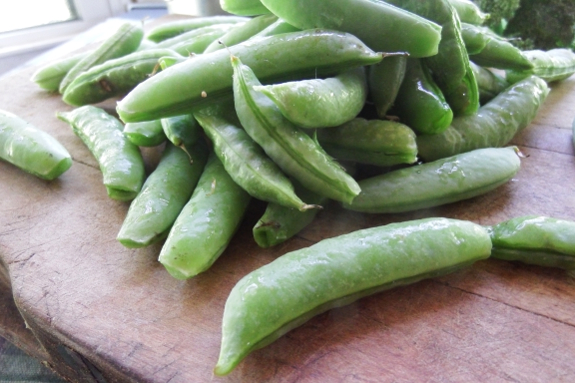
Germination in cold garden soil was mediocre and some vines are succumbing to fusarium wilt just like every other year.
But yields are tremendous and the sweet pods are delicious. It's hard to complain about sugarsnap peas.
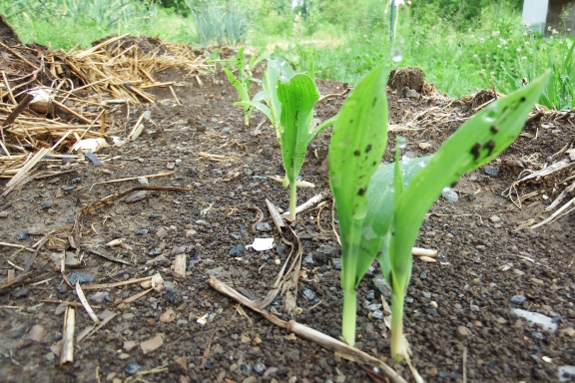
Last year, I
decided that I wasn't going to grow field corn again for the goats.
My reasoning? I'm
leery of feeding ruminants grain unless you really have to, and our
spoiled darlings didn't like the field corn leaves nearly as much as
they enjoyed sweet corn leaves. Overall, the crop didn't seem like a
good use of our limited compost.
But pictures don't lie.
That's a long double row of field corn growing on my garden. What's up?
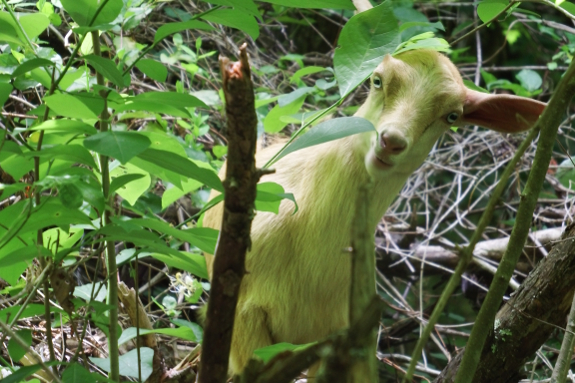
While Artemesia was
getting her motherhood feet under her in late April and early May, she
went through last year's field corn like it was candy. Our doe would
eat greenery at the time, but only if I sat beside her and tended
to her kids so she knew they were okay. I'm ashamed to say I didn't
have two hours a day to feed even my favorite goat, so I babysat
sometimes...and sometimes I fed the nervous mother corn that she could
snarf down in a few short minutes at the end of a long, tiring day.
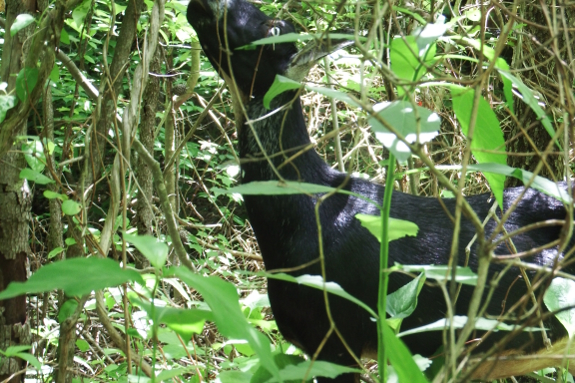
I ran out of corn not
too long after Artemesia finally started taking the kids out to graze.
And while milk production lowered by about half a cup per day after she
went off
the grain, Artemesia's coat looked shinier and her fat deposits
stayed at a good, healthy level on the new/old diet.
As a result, I don't plan to keep graining her (even though it would
likely increase milk yields)...but I do want to have corn on hand for
next year. In a
perfect world, Artemesia's second go at motherhood will be less
emotionally fraught for both of us. Still, it's good to have quick
fixes available just in case.
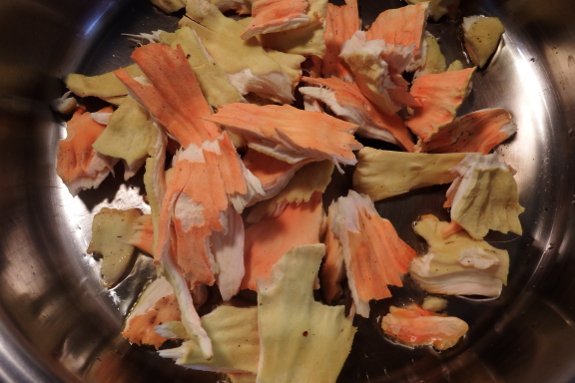
This post is to remind us that last June we found some delicious chicken of the woods mushrooms from a red oak and it might pop up again this year.
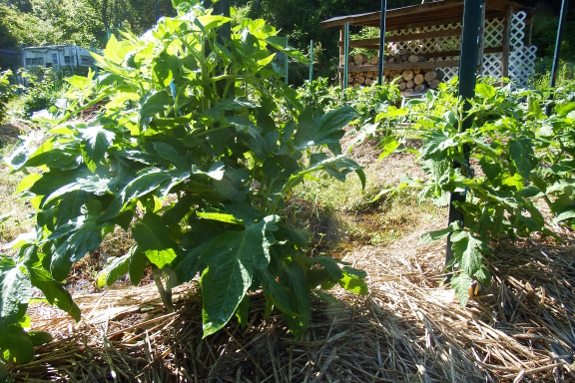
In May, I would have
told you that the addition of lights to our seed-starting setup means
that we need to move our starting date forward a couple of weeks. Since
I started them at my usual time, the seedlings spent nearly two months
inside and ended up leggy and yellowing despite having been potted up
from their flats. We planted
the tomatoes into the garden prematurely and had to bury the stems
very deep to make up for their stunting. Still, the poor things
lingered and frowned at me for two weeks before they started to grow.
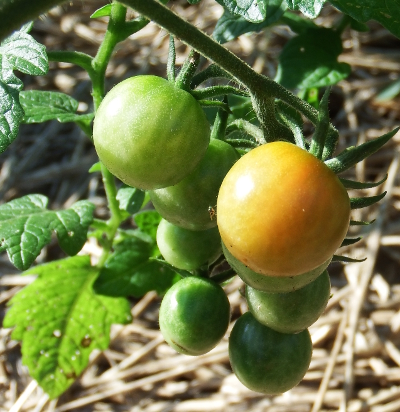
But when they started to
grow, they started to grow. And, look, a tommy-toe
tomato that will likely ripen up this week, three weeks earlier than in
previous years.
So maybe the headstart
was worth it? Only the final yield and the plants' reaction to our
inevitable round of blight will decide.
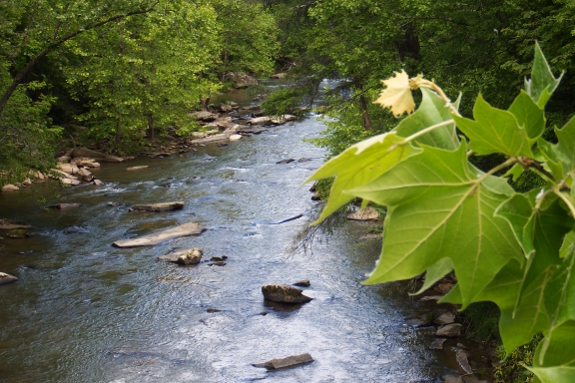
I went on a
brain-cleansing hike Wednesday at the Guest River Gorge. As the name
suggests, the river runs between steep cliffs, paralleling the trail
and providing a soothing soundtrack for the entire day.
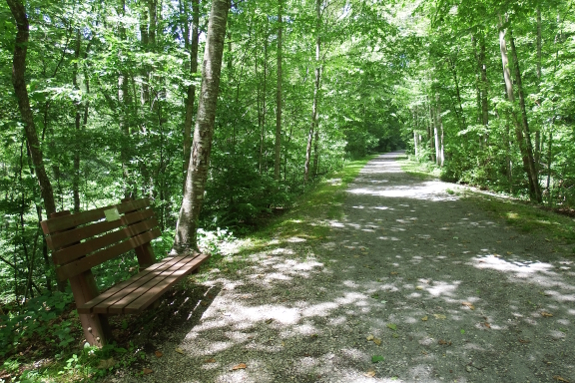
The trail itself is one
of those rails-to-trails deals, meaning that it's more of a road than a
trail. If you go on a pretty weekend, the place is packed. But at 8 am
on a Wednesday morning, I saw no one until I'd walked all the way to
the end and was 50% of the way back. Perfect!
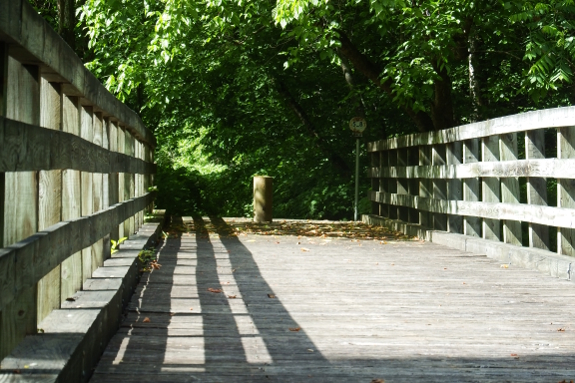
The only really hard
part of the trail is the length --- 5.8 miles one way...then you have
to walk uphill for the entire return journey. I'm intrigued by the
option to instead take a left just before the end and follow the Heart
of Appalachia trail over to Sugar
Hill. But I've never been able to find the connection on the Sugar
Hill side, so I'm a bit leery. (The connection on this end was
well-marked and obvious.)
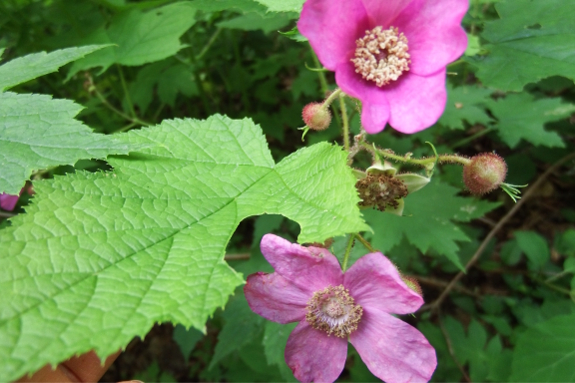
Despite the
high-trafficked nature of the upper two to three miles, the Guest River
Gorge Trail is a good spot for botanizing since it's located at a high
elevation. I was very taken with these purple-flowering raspberries, in
full brilliant bloom. (Although my reading suggests it's not worth
going back in search of the berries --- as with the Pacific Northwest's
salmonberry, the prettier the flower, the more insipid the fruit.)
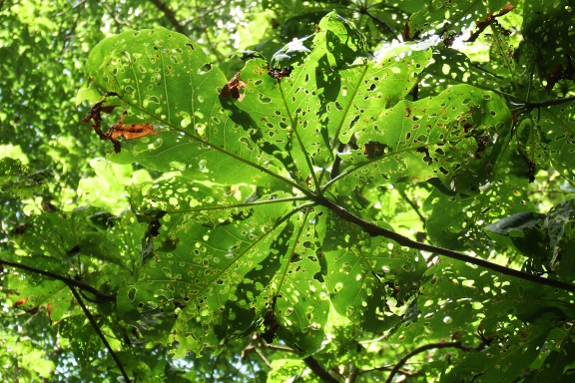
Views like this one put
any slightly insect-damaged plants in my own garden into perspective.

But my favorite spot was
a particular part of the cliff that captured the sound of the river and
turned it into an ocean-like symphony. I hesitate to tell you exactly
where it is --- if I do, you have to promise not to leave your trash in
my favorite location and not to show up at 8 am on a Wednesday morning
to steal my hideaway.

Promise? Good. Just at
the two-mile marker, you'll see a ledge easily accessible via a short
scramble up a scree slope. Clamber on up, then lie back and relax. 99%
of passing hikers won't even know you're there and the roar of the
river will lull you into true relaxation. Enjoy!
It's that time of year when dock weed is going to seed.
Dig it up now or make peace with its new offspring.
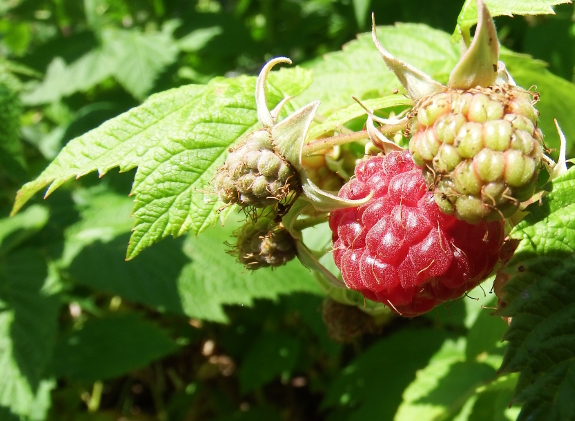
Another day, another
variety of berry on the table. I do miss the passing of peak
strawberry season, when I was able to gorge on half a gallon of berries
per day all by myself. But the blueberries and red and black
raspberries are quickly picking up steam and promise to fill in the gap.
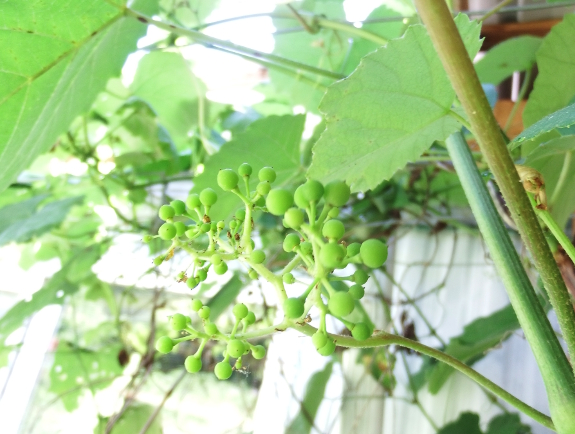
Meanwhile, I'm trying
not to get my hopes up about the grapes that are starting to swell on
their vines. Monday's
anti-blight campaign
seems to have removed most of the fungal issues, so I'm keeping my
fingers crossed that we won't end up with rot spots on the fruits once
they reach full size and begin to fill with sugars.
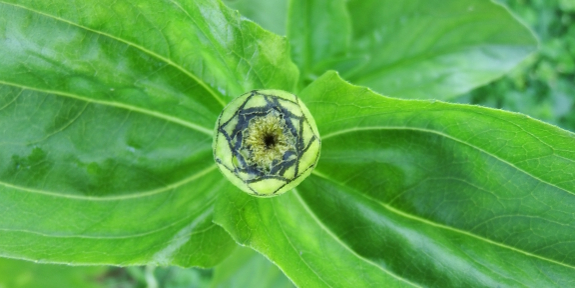
All in all, a very
fruitful week.
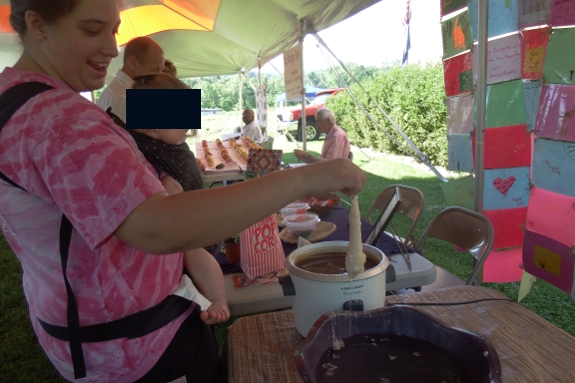
Kayla knows more than
anyone I've ever met about having fun close to home and on a budget.
She and baby D (face hidden for legal reasons) spirited me away to the
Copper Creek Birds and Blooms Festival on Saturday. We dipped candles,
won free rain barrels, and generally had a ball.

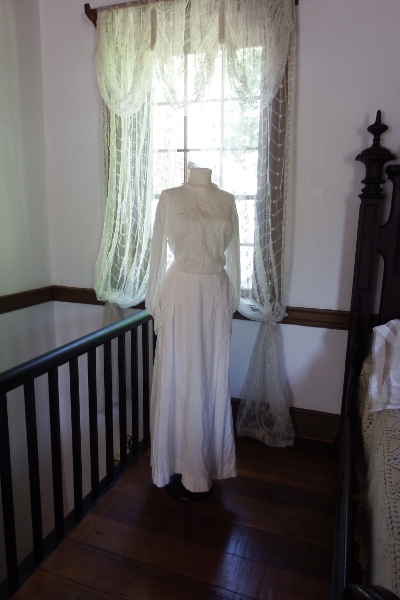 The event is located at the
Old Russell County Courthouse, which I'd driven past approximately a
million times without stopping. Although small, the historic area is
well worth a visit if you're already in the area.
The event is located at the
Old Russell County Courthouse, which I'd driven past approximately a
million times without stopping. Although small, the historic area is
well worth a visit if you're already in the area.
Our tour guide explained
that the courthouse (active in the late eighteenth and early nineteenth
centuries) was important for land disputes, with criminal cases being
tried down the road in Abingdon. Still, criminals were often brought to
this courthouse, where they were held for the day in the basement cell
then housed by the judge's family at night. Gives a whole new meaning
to taking your work home with you....
(The second picture in
this post, I know, isn't particularly historic even though it graces
one of the upstairs walls in the courthouse. But I'm including the
print for my mother since the shepherdess reminds me of the paintings
hanging in her mother's upstairs hallway when I was a child.)
Anna harvested today what I think is our largest head of cabbage to date.
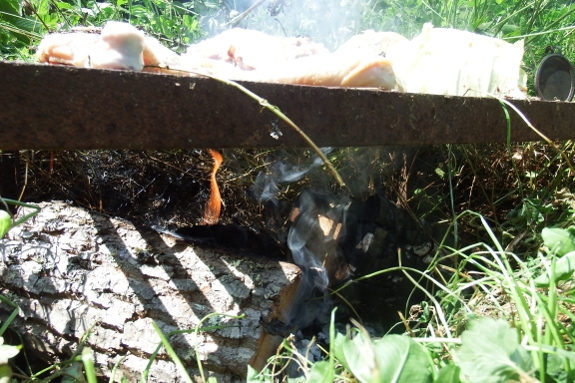
I made a fire pit in our
outdoor
living room last
year...then never really used it. But I had a marinated chicken in the
fridge Sunday morning and a grill-friendly brother coming over for
lunch. So I decided to give it a whirl.
I whacked the chicken
into four parts and put them on a the grate once the wood underneath
had been burning for about an hour. I did end up having to slice the
thickest part of the legs and breasts near the end to get everything
well cooked without charring the skin, but the taste was delectable.
Bonus: the house didn't
turn into an oven despite another day with highs in the mid nineties. I
should obviously cook in the outdoor living room more often. It's even
shaded until nearly noon!
We decided to delete scarlet runner beans from our garden this year.
It seemed like they attracted bean beetles that impacted our Masai beans.
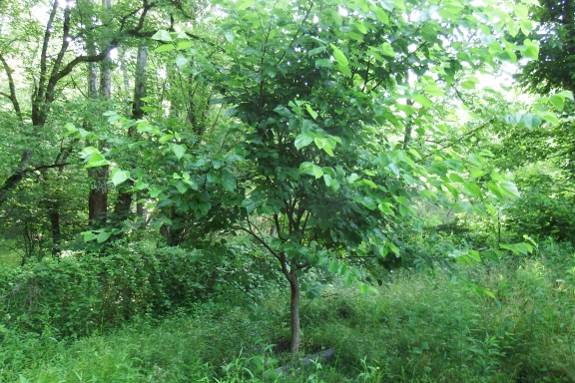
After learning the hard
way that, no, mulberries really don't fruit much if half-pollarded
each year, I
regressed to the absolute opposite technique --- ignore the tree and
see what happens. The result? Our tree is loaded with fruits this year.
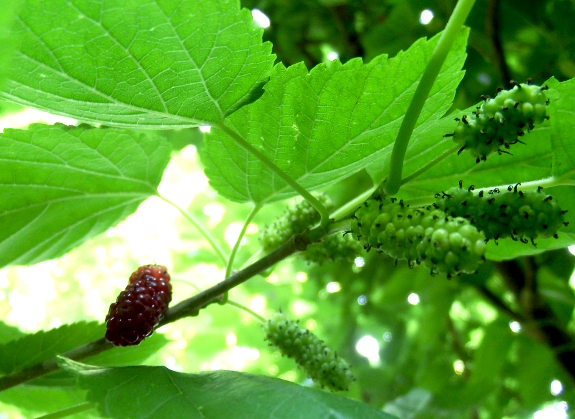
The downside of the
leave-the-tree-alone technique is that I can't actually reach most of
those berries. And since we chose an Illinois Everbearing tree (which
ripens fruits slowly over multiple months), the techique of shaking the
tree isn't really worth it. So the wild birds are getting most of the
crop.
I think pruning/training
experiment #3 will be pulling the limbs down into an open-center system like we did with our peach
trees. Maybe the tree will still bear heavily and I'll still be able to
reach the fruit? Only time will tell.
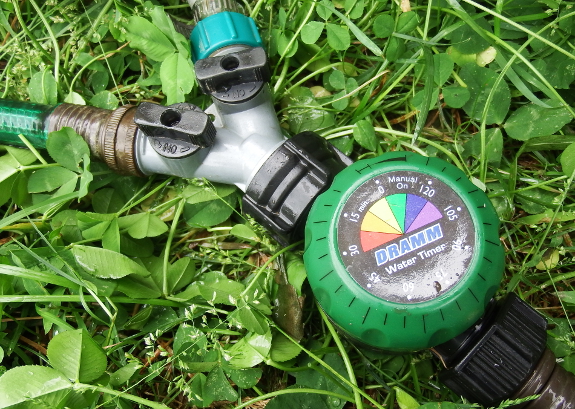
This mechanical hose timer does a good job at turning on and off.
The problem for us was how it
decreased our already low water pressure and how that affected the drip
irrigation we tried last year on the tomato plants.
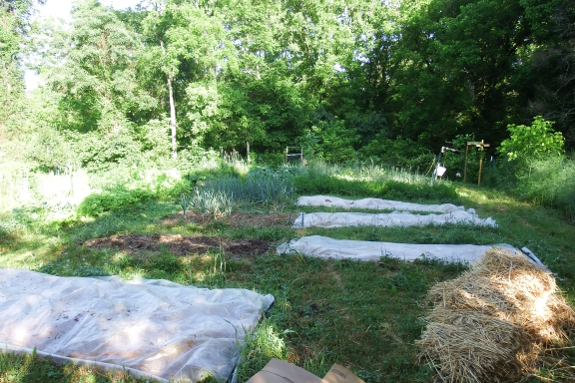
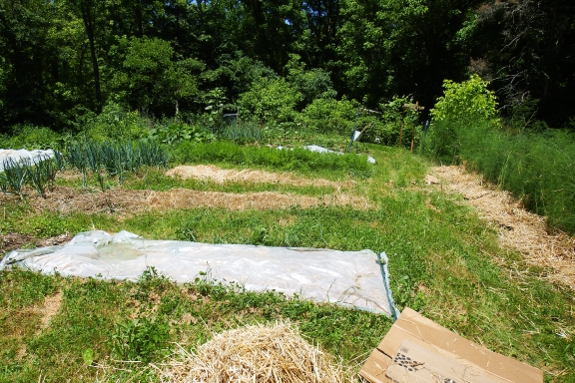 What do you do if you cut
your rye repeatedly for goat fodder, meaning that it never quite
manages to bloom and thus to be easily
killable by mowing? Solarize, of course!
What do you do if you cut
your rye repeatedly for goat fodder, meaning that it never quite
manages to bloom and thus to be easily
killable by mowing? Solarize, of course!
It's been so blazing hot
here recently that the clear plastic required less than a week to
completely bake the rye underneath. Only the most shaded bed (in the
foreground) had to remain covered when I checked my solarization beds
Monday. The other sheets of plastic moved on to kill some old lettuce
that I was too lazy to pull up.
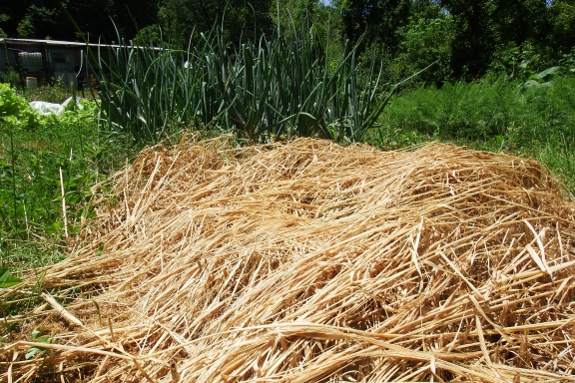
The solarized rye now
looks like a thick coating of straw just waiting to be planted
into...but it isn't. As with mow-killed rye, I'll need to wait at least
two more weeks for microbes to decompose woody roots before it's safe
to set out seeds or transplants into the dead cover crop. If I was in a
big hurry, I could instead lay down a heavy dose of compost...but I've
got more time than compost at the moment, so I'll cool my heels.
If the links above don't
sate your interest, you can read more about solarization
(and other small-scale no-till tricks) here and can read more
about no-till cover crops here. Enjoy!
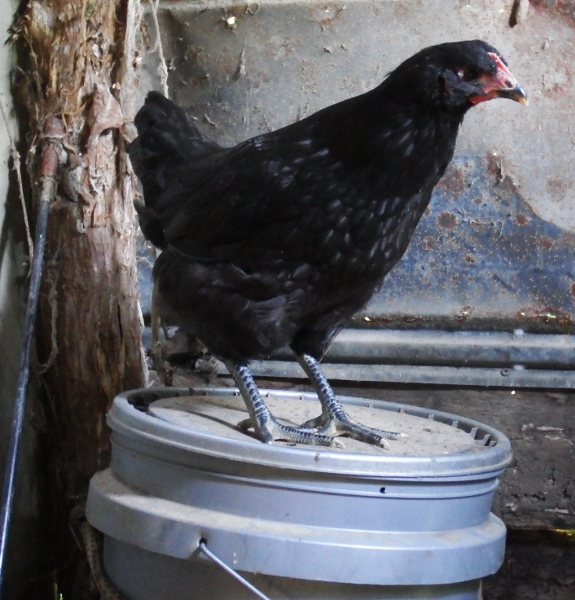
I think we only lost one bird.
Regardless, we'll keep shutting them in at night a little longer.
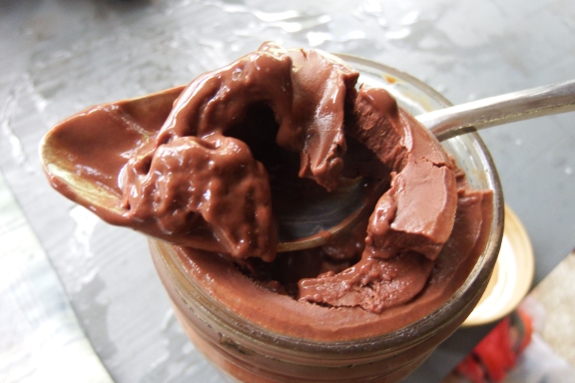
It's been blazing hot
here with local weather stations hitting record temperatures for June.
Meanwhile, our fridge is full of excess milk that I'm too tired to turn
into cheese.
"Homemade ice cream?"
Mom suggested. You don't have to ask me twice --- I'm sold!
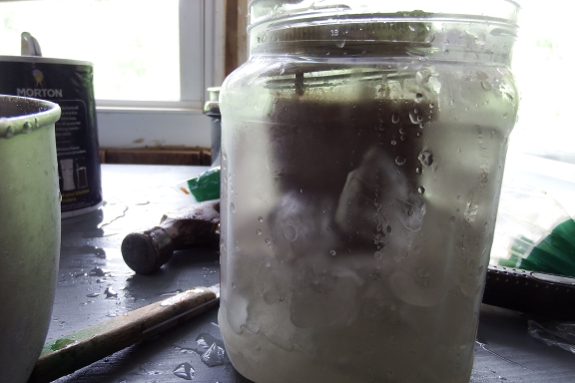
I wanted to make a very
simple ice cream, so I first mixed the following ingredients and began
to warm them over medium-high heat:
- 3/4 cups milk
- 3 tablespoons of cocoa
- 3 tablespoons of sugar
- 1/16 teaspoon salt
- 1/4 cup of dark chocolate chips
Meanwhile, I mixed these
other ingredients:
- 1/4 cup of milk
- 1 tablespoon of cornstarch
- 3 drops of mint extract
I added the cornstarch
mixture to the warming chocolate mixture, then heated until just barely
boiling to thicken my chocolate milk. After that, I removed the mixture
from the heat and cooled it thoroughly in the refrigerator.
Part two began three
hours later when I froze the ice cream. I don't have any fancy
equipment, but I do have ice cube trays, table
salt, random cleaned out food containers, and a hammer. That appeared
to be quite sufficient.
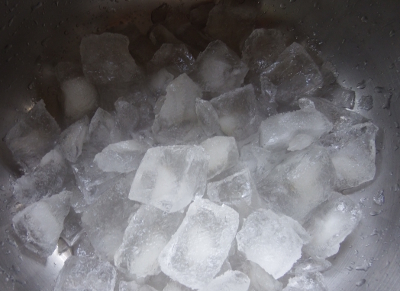 I crushed the ice cubes with
the hammer, mixed in salt, and packed the frozen salt water around the
small jar inside the larger container. Then I rocked the outer
container with my foot (like a cradle) for about ten minutes, at which
point I really should have added more ice.
I crushed the ice cubes with
the hammer, mixed in salt, and packed the frozen salt water around the
small jar inside the larger container. Then I rocked the outer
container with my foot (like a cradle) for about ten minutes, at which
point I really should have added more ice.
Since I was out of ice, I instead, stirred the halfway frozen ice cream
and put it in the freezer. Another couple of stirs at hour intervals
resulted in a delicious dessert that didn't seem to suffer from lack of
cream and eggs.
Yes, I'll definitely be
trying this again with a larger batch soon. I think I'll freeze a tray
of salted water next time, though --- after all, if I'm going to be
whacking my ice with a hammer, I might as well get the colder cubes the
easy way.
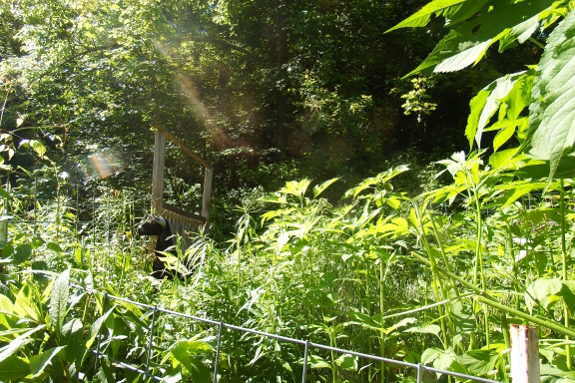
Last year, our goats
barely nibbled in their summer pastures. But after twenty months of
manure deposition, the soil is finally fertile
enough for plants to
grow. And grow they have!
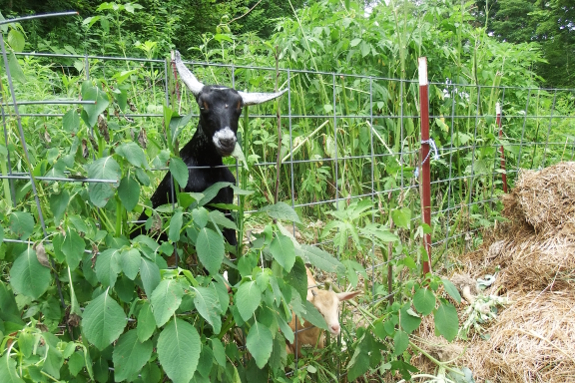
This photo was taken six
days after the first image in this post. Artemesia, with the help of
her kids, has eaten away all of the choice greenery within neck reach
of the fence and has squirted out three quarts of excess milk for us to
enjoy in the process.
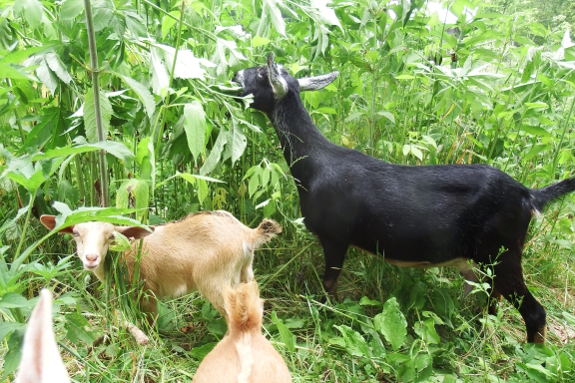
Time to bend down some
of those extra-tall ragweed plants in the center of the pasture so our
dwarf goats can continue chowing down!
Overall, I'd say
Artemesia is now getting half of her daily greenery ration off the
pasture, which is a good start. (I still take her out in the evenings
to graze in the woods.) Perhaps in a year or two, we'll have a couple
more pastures and yet more fertility in the soil and won't have to
worry so much about rustling up extra-curricular forage for our goats.
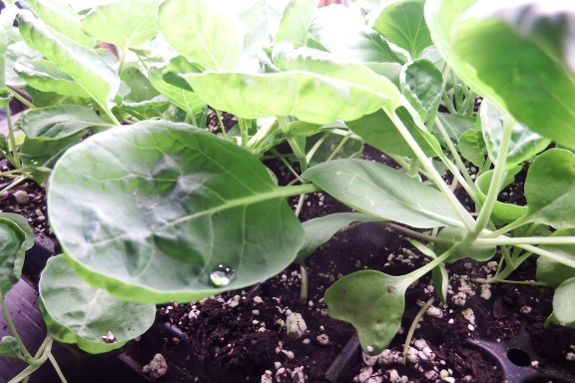
Next week, garlic will make way for their understudies.
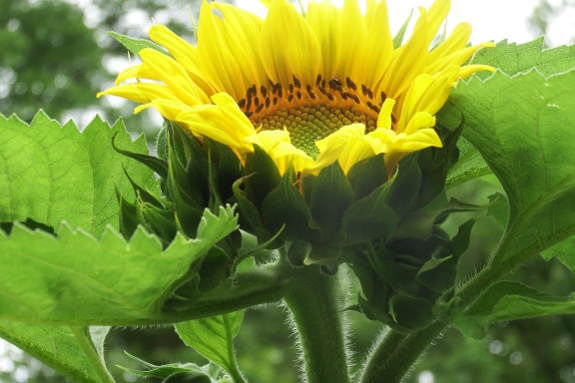
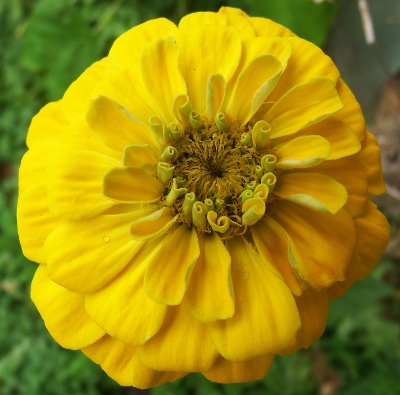 I don't leave much room for
entirely ornamental flowers in our garden. Which isn't to say that the
space isn't vibrant with color at certain times of the year.
Sunflowers, for example, are one of Artemesia's favorite concentrates.
Zinnias? Well, they're just around to be pretty, I guess.
I don't leave much room for
entirely ornamental flowers in our garden. Which isn't to say that the
space isn't vibrant with color at certain times of the year.
Sunflowers, for example, are one of Artemesia's favorite concentrates.
Zinnias? Well, they're just around to be pretty, I guess.
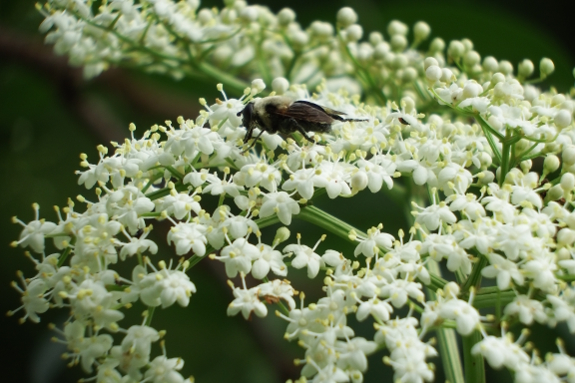
The elderberries I have
here and there are technically both edible and medicinal. But I mostly
just let the plants grow because they were here first and they're
awfully tough to root out. Both bees and birds enjoy the plants at
different times of the year.
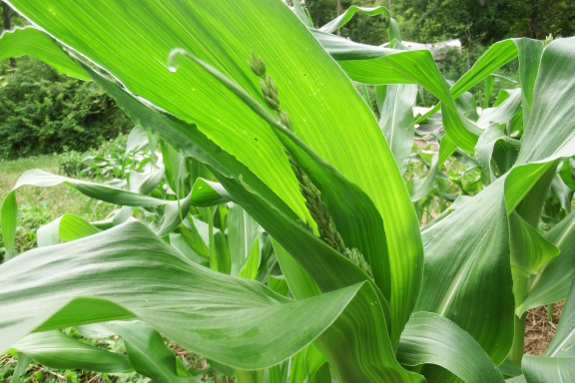
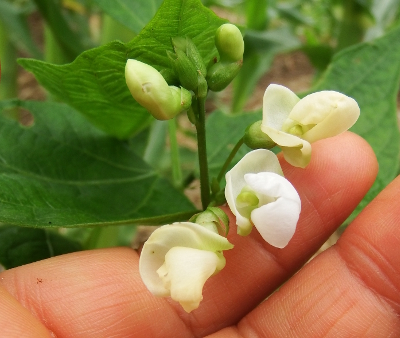 The
flowers I watch more carefully aren't nearly as pretty...but they're
going to be much tastier!
The
flowers I watch more carefully aren't nearly as pretty...but they're
going to be much tastier!
The first corn and bean flowers popped up this week, promising summer
vegetables in the near future.
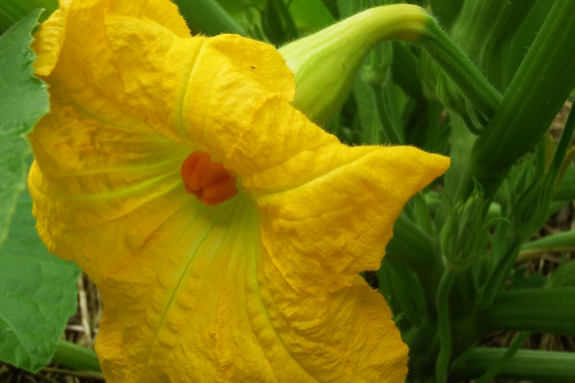
And then there are our
crookneck squash plants, which combine beauty and edibility with their
massive yellow blooms that turn into copious fruits. If the petals
weren't so fleeting, I think city dwellers would plant these in their
front yards.
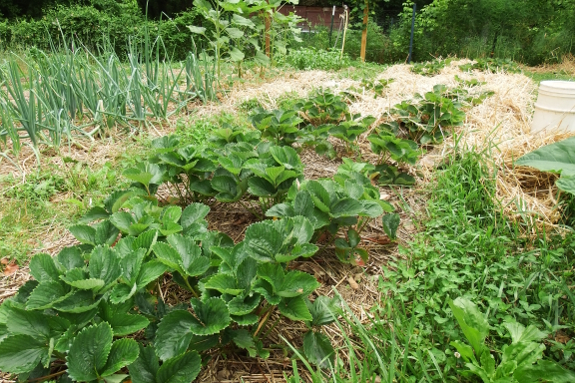
We ran out of composted goat manure halfway through this bed, so the rest of the plants got chicken coop bedding.
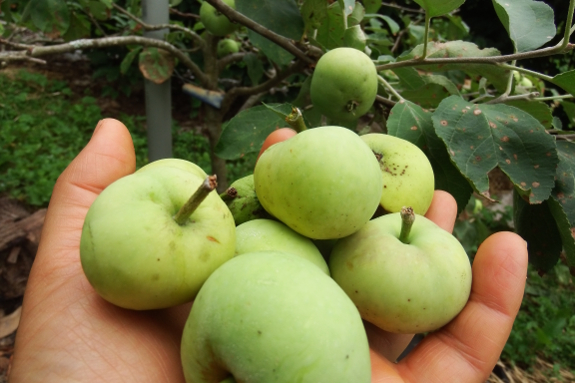
We've never had an apple
tree that set as many fruit in as small a space as our high-density
Early Transparent.
So I guess I shouldn't have been surprised that this is also the first
time we've experienced June drop.
What's June drop? Fruit
trees naturally
shed tiny fruitlets soon after blooming, but the trees sometimes
have a second round of self-thinning about eight weeks later as well.
This so-called June drop can be natural, or it can be due to
mismanagement. In our case, I think the cause is a little bit of both.
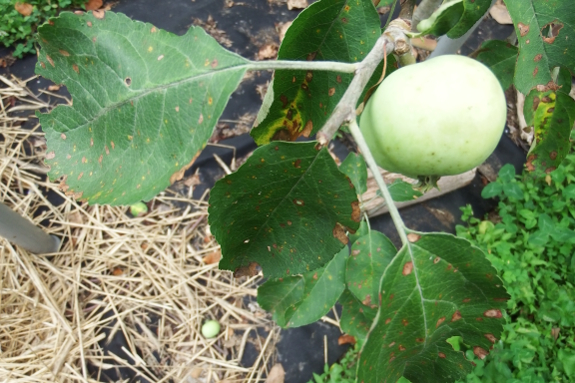
What did I do wrong? The
tree in question is located just out of range of our sprinklers, so
lack of water may have been a contributing factor.
Similarly, I didn't
fertilize this row at all last year because I didn't want to waste any
of my limited compost on trees whose flowers kept freezing rather than
setting fruit. Lack of nitrogen, like lack of water, can spur June drop.
Finally, I summer
pruned the tree pretty hard at the beginning of this
month, and the resultant paucity of leaves might have made the tree
feel like it couldn't handle as many fruit as it had originally chosen
to keep.
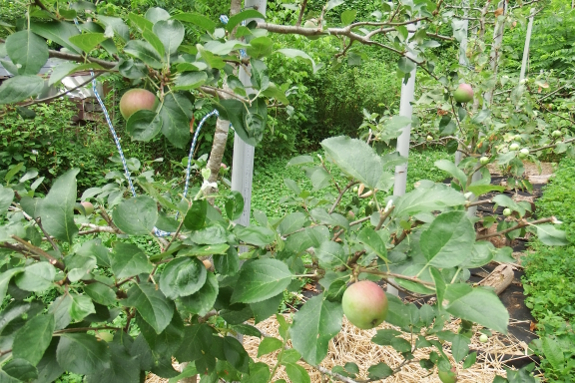
I'll mitigate some of
those practices in later years. But, for now, I'm nibbling on the June
drops, which actually taste pretty good if you're a sour-fruit lover.
Meanwhile, I'm watching the neighboring tree, which is holding onto its
fruits and swelling them up even faster than the Transparent is. So
perhaps the latter just had too many fruits to handle after all and I
shouldn't be terribly concerned about June drop.
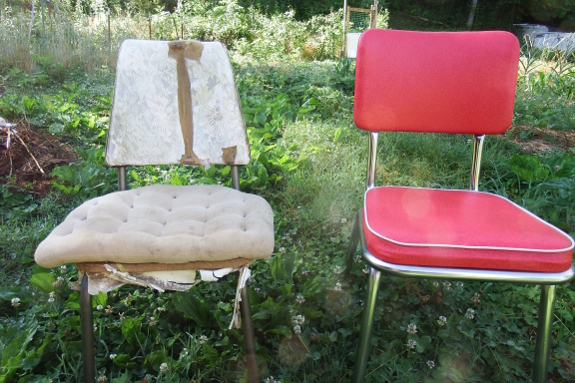
Nine years ago, my
father gave me two kitchen chairs that his significant other didn't
feel matched their decor. I adored them...past when the cushions wore
out and straight up until the legs literally fell off one of the seats.
In need of another set
of chairs, I decided it was Mark's turn to hit up family. I sent him to
Ohio with strict instructions to come home with replacement chairs. The
beautiful red chair on the right (and its twin) belonged to his
mother's significant other...until Mark snuck them into our car and
made off like a bandit.
Thanks, Daddy and
Barbara and Rose Nell and Jayne for what I hope will be 20 years of
free chairs!
We tried a new tripod sprinkler today.
A more elegant solution that's easier to move compared to the sprinkler heads we have mounted on top of a fence post.
I like the way the hose hooks up from below.
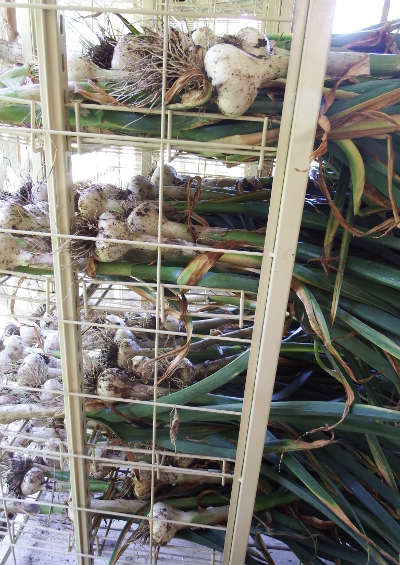 96 heads of garlic
went from ground to curing rack Monday in celebration of the summer
solstice.
96 heads of garlic
went from ground to curing rack Monday in celebration of the summer
solstice.
We still have about15
heads leftover from last year, but Artemesia won't mind at all adding
the pungent cloves to her diet for the next few weeks until they're all
gone.
By then, the new heads
will be dried and ready to pack away for the next year of seasoning and
planting.
Full circle gardening at
its best!
This week has been dry enough to use the ATV.
Out goes the garbage and in comes straw bales.
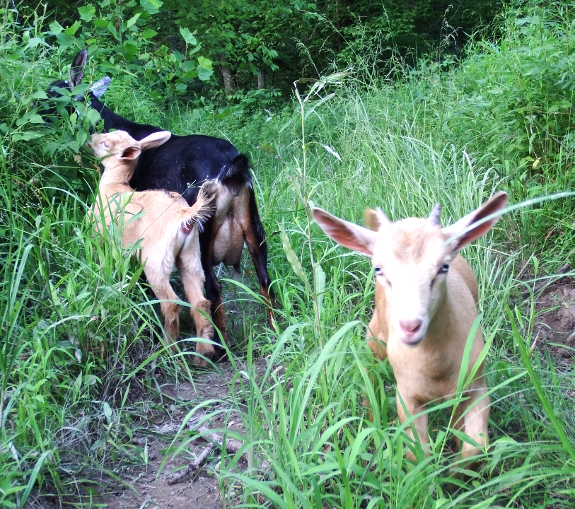
Guess who's two months
old today? That's right, our twins are growing up!
(Warning: R-rated
information follows.)
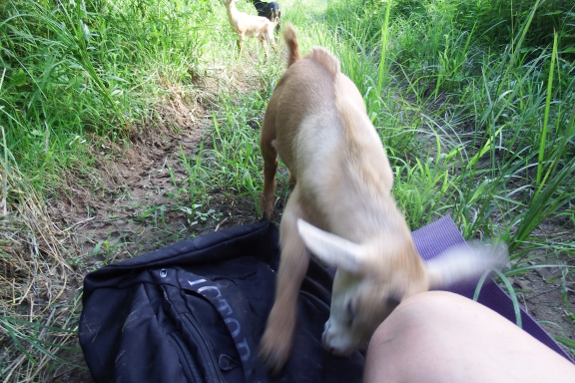
Unfortunately, two
months old for a buckling means Punkin has become a cantankerous and
randy teenager. The endless headbutting is annoying but manageable.
However, his other MO --- endlessly humping his sister --- is more
problematic. He's already reached the stage where he gets an erection (and
licks the stream of his urine --- delightful), meaning that he could
possibly knock his sister up.
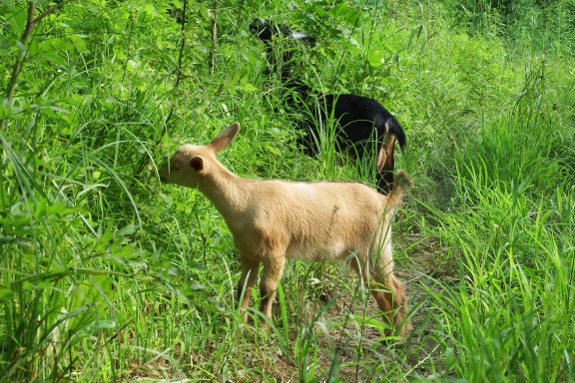
Unfortunately, my goat mentor says two
months old is a little dicey for weaning. Our kids have started really
eating solid food in the past week, but their rumens probably still
depend on receiving a mixture of milk and greenery. So this week we
hope to figure out a way to separate Punkin while still letting him
have daily nursing visits with his mama. Yes, I'm well aware that much
screaming is going to ensue --- I just hope I'm not the one who ends up
throwing the biggest tantrum.
How many Brussels Sprout plants did we set out today for the Fall garden?
45.
Could be our highest yield of Brussels Sprouts.
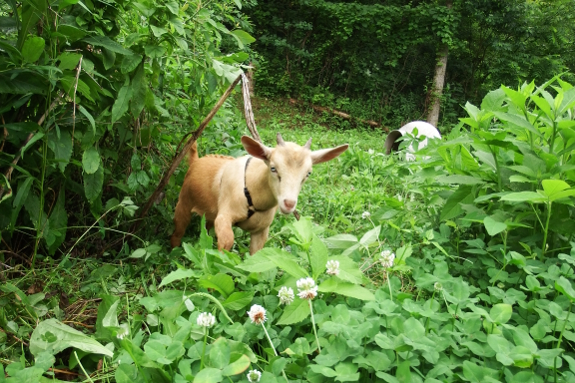
Mark and I tossed around
a lot of solutions for our
randy buckling problem. A chastity belt for Aurora. Various types
of pastures for Punkin. In the end, the only thing we were confident
would hold him during the first few upsetting days was a tether.
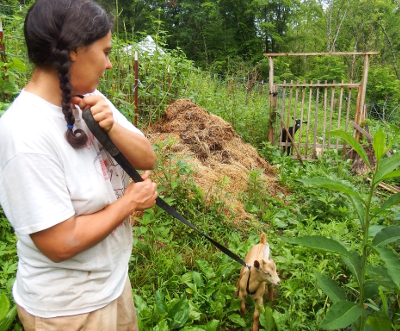 Sure
enough, the yelling commenced as soon as we slipped a harness on Punkin
and led him away from the pasture. I'm not sure who was more upset ---
me, Punkin, or Artemesia. Aurora, on the other hand, got over losing
her paramour pretty darn fast.
Sure
enough, the yelling commenced as soon as we slipped a harness on Punkin
and led him away from the pasture. I'm not sure who was more upset ---
me, Punkin, or Artemesia. Aurora, on the other hand, got over losing
her paramour pretty darn fast.
The game plan is to see
if Punkin will take a bottle so I can slowly reduce his milk intake
until he's 100% on grass. If he won't drink from a bottle or a pan,
we'll go for supervised visits, although I'd like to let mother and son
forget each other as soon as possible. Hopefully by the middle of July,
all of this drama and trauma will be behind us.
I tried to fix a cut in our hose with gaffer tape.
It should be more easy to mow over than two hose clamps.
After a day of full pressure there was no sign of any leaks.
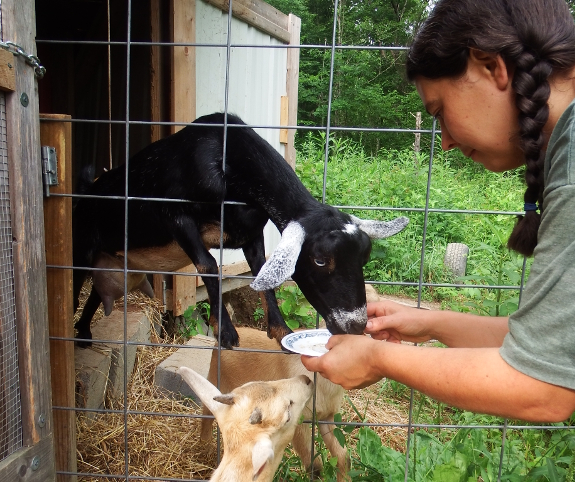
I'm totally sold on copper
boluses for our
goats. It's been two months since Artemesia's
first treatment, and
I was surprised to see how much orange showed back up in her hair
during the intervening period. The change in hue is a clear sign that
she was deficient in this important mineral despite having free-choice
access to kelp and a salt/mineral mixture, so I'm glad I finally
figured out the essential caprine supplement.
Our doe isn't all the way back to her original coloration, though,
probably because
I was careful and only gave her the bare minimum amount of copper
recommended for a goat her size the first time around. So I decided to follow
Dr. O'Brien's advice
and give her another dose.
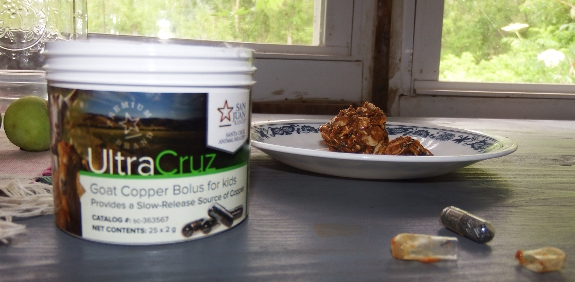
At the same time, I'm
bolusing our kids for the first time too. The stress of weaning can
cause worm overloads, so now's a good time to make sure Punkin gets off
to a good start. My planned dosages 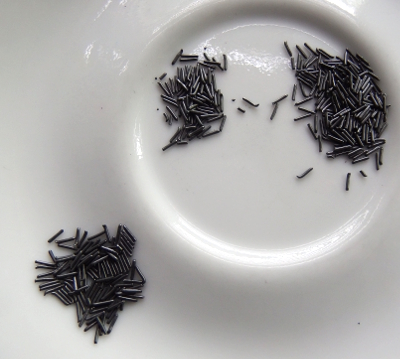 were 1 gram for Punkin
(because
he's huge and being weaned), 0.5 grams for Aurora (because she's
smaller and not being weaned), and 2.5 grams for Artemesia.
were 1 gram for Punkin
(because
he's huge and being weaned), 0.5 grams for Aurora (because she's
smaller and not being weaned), and 2.5 grams for Artemesia.
Unfortunately, my
no-bake bolus balls were still a bit too big to be eaten in
one go. So Artemesia
actually got about 1.25 grams, Punkin got 0.5 grams, and Aurora got
nothing. I'll try them again this afternoon to see if they'd like
another dose, but I'm also pretty willing to be content with that
dosage since I'm allowed to readminister as early as six weeks. Here's
hoping that by then Artemesia's belly is once more as orange as it was
when she was a kid.
We met a new neighbor today.
Freddy sold us a dump truck load of his horse manure for 75 dollars.
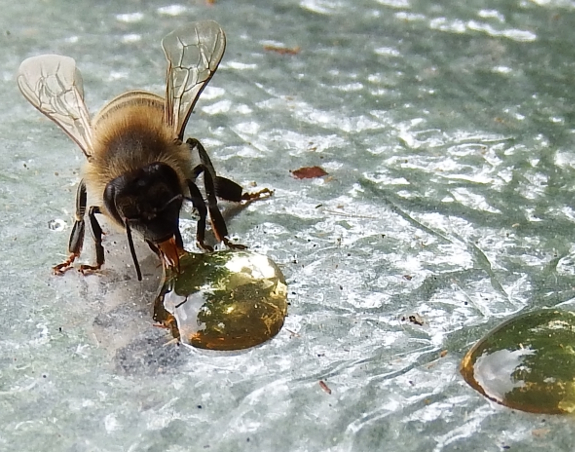
At long last, I can
report good news from the apiary! Both hives are so busy I had to add
an extra box apiece. And our basswood
tree is blooming this year, so we might actually get to harvest honey
despite our spring
swarms.
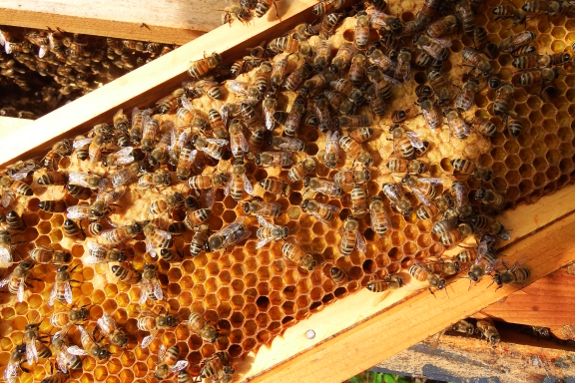
The even better news is
that the queen is finally laying in the Langstroth part of our hybrid
hive. There's still brood in the Warre box, so I can't complete the
transition just yet. But hopefully I'll soon be able to take that top
box off and remove it with honey inside.
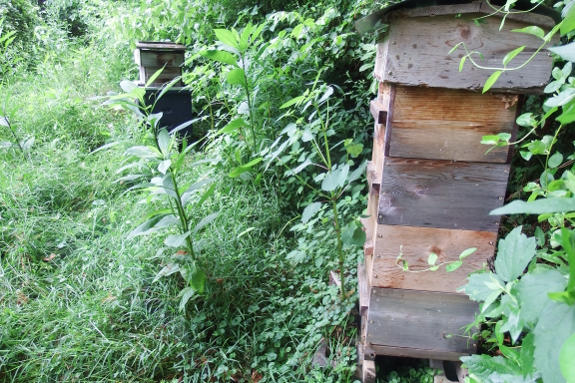
Tall hives are a good
sign, especially when all but one box in each is drawn and in use. I
checkerboarded new frames between drawn frames in the Langstroth hive,
which seems to be handy for getting the bees to use the new space
faster. In the Warre hive, I instead had to put an empty box in the
stack second from the bottom. Here's hoping the bees put both annexes
to good use soon and keep up the good work.
We are trying out a new product made by a friend of a friend called Plant-Scaper.
Anna likes the way it looks and I like how easy it is to set up and store.
A nice upgrade from those tomato cages that take up way too much space.
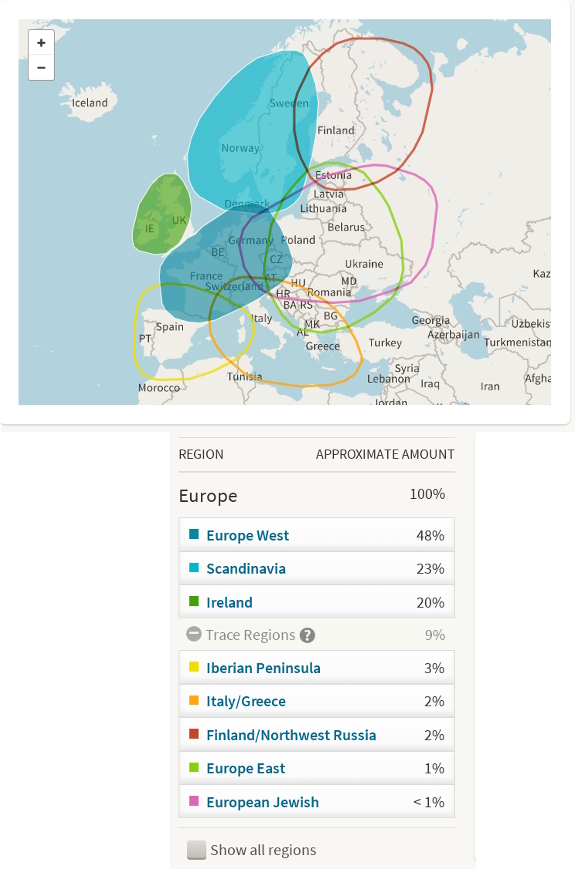
In Mom's family, there's
always been talk of "that woman," who introduced dark coloration to the
family. The romantic notion is that she was a gypsy shipwrecked off the
coast of New England. We decided to find out if that was really the
case, so Mom spit in a tube and we sent in her DNA to be analyzed.
 Two of Mom's grandparents came
to the U.S from Sweden during their lifetimes, so it's unsurprising
that Scandinavia makes up such a large chunk of her DNA markers.
The actual percent Scandinavian could range from 0 to 46, so I'm going
to guess that the average shown is a bit of an underestimate.
Two of Mom's grandparents came
to the U.S from Sweden during their lifetimes, so it's unsurprising
that Scandinavia makes up such a large chunk of her DNA markers.
The actual percent Scandinavian could range from 0 to 46, so I'm going
to guess that the average shown is a bit of an underestimate.
 The Rhode Island wing of Mom's
family can eventually be traced back to at least one ancestor who came
to North America in 1630 from England...and a bunch of other ancestors
with who-knows-what background. Based on Mom's DNA test results, it
looks like many of these unaffiliated ancestors may have been Irish or
from Western Europe (although Mom says Wales is the location most
spoken of in her family).
The Rhode Island wing of Mom's
family can eventually be traced back to at least one ancestor who came
to North America in 1630 from England...and a bunch of other ancestors
with who-knows-what background. Based on Mom's DNA test results, it
looks like many of these unaffiliated ancestors may have been Irish or
from Western Europe (although Mom says Wales is the location most
spoken of in her family).
What about "that woman"?
Maybe she was from Spain, Portugal, Italy, or Greece. Or maybe it was
just dark Irish coloration coming through. Unfortunately, the ancestor
in question has been dead for many, many years, so there won't be any
DNA test results to find out for sure.
When Anna first moved here she found a white plastic chair in the creek.
It quickly became her office chair behind her desk.
I tried to get her to upgrade but was met with the same "I love my chair!"
Every year I bring it up at least once and this year I finally won that argument and convinced her to upgrade to a proper Executive chair.
She reports better posture and less aches after long hours of writing.
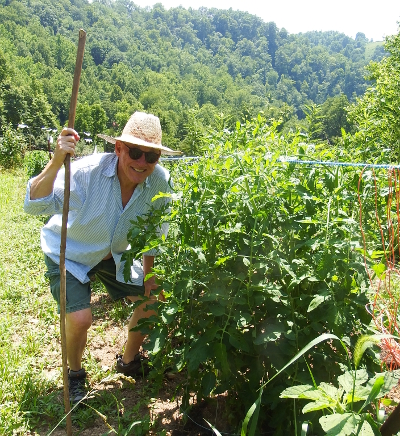 Several
of you were concerned about chemical contamination in our
horse manure.
Luckily, we live in an impoverished area where excess chemicals aren't
used that often simply because they're expensive. Here's
my previous post on the topic. If our farm was located in
Lexington or northern Virginia where pastures are weed-free and
perfectly manicured, I'd be much more concerned.
Several
of you were concerned about chemical contamination in our
horse manure.
Luckily, we live in an impoverished area where excess chemicals aren't
used that often simply because they're expensive. Here's
my previous post on the topic. If our farm was located in
Lexington or northern Virginia where pastures are weed-free and
perfectly manicured, I'd be much more concerned.
That said, whenever you
find a new source of organic matter, it is
a good idea to test it out before going hog wild. Luckily, we found out
about this year's horse manure from a homesteading buddy and he got his
dump-truck load a solid month before we did. A picture is worth a
thousand words, so I'll let his tomato plants speak for themselves. In
fact, when I asked him what he thought of the fertility source, he
sounded like a born-again organic gardener. "All the years we've been
gardening," he said, "I can't imagine why we didn't add manure to the
soil!" So it sounds like
the manure isn't only safe...it's turbo-charged!
Aurora was not acting like her normal happy self this morning.
We took her in for a vet visit and she got a vitamin shot with some vaccine boosters.
She's feeling a little better and might just be feeling the switch from Mother's milk to weeds and leaves.
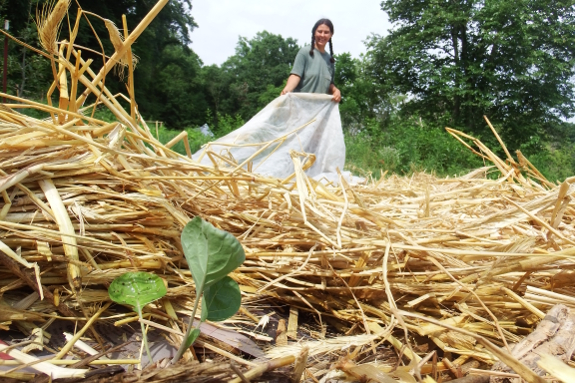
When it comes to bad
bugs in the garden, a stitch in time definitely saves nine.
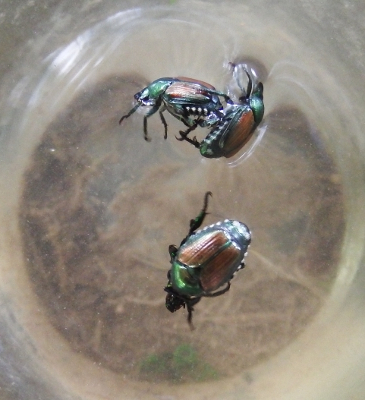 Last week, the first Japanese
beetles showed up in our garden. I pick intruders once or twice a week
at this time of year, simply dropping the beetles into a cup of water
that I later pour into the chicken tractor. Since these beetles set up
mating territories when they first appear, if you snag the early birds
you'll end up with little damage later in the season.
Last week, the first Japanese
beetles showed up in our garden. I pick intruders once or twice a week
at this time of year, simply dropping the beetles into a cup of water
that I later pour into the chicken tractor. Since these beetles set up
mating territories when they first appear, if you snag the early birds
you'll end up with little damage later in the season.
Cabbage worms are a bit
trickier. I mostly try to avoid them by not having crucifers in the
garden during the summer months. This year's early broccoli was perfect
since we harvested nearly all of the heads before the voracious
caterpillars showed up. But I wanted to plant brussels sprouts early to
get a head start on the winter growing season. What to do? How about
covering up those beds with row-cover fabric to avoid the bug problem
entirely?
If you'd like to learn
more about my low-work, completely chemical-free pest-control
practices, I hope you'll check out my book The Naturally Bug-Free
Garden. Hopefully
your garden ecosystem will be more complete and your harvests more
abundant after the read.
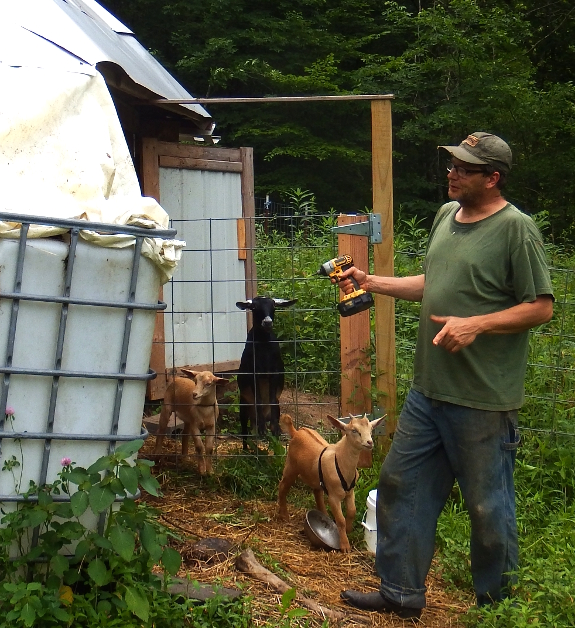
So, the good news is
that I realized on weaning
day two that one of our goat pastures had chicken wire around the base
that could keep Punkin in. Once our buckling was able to nose his
mother through the fence, he calmed down quite a bit. He still wouldn't
take a bottle or drink out of a pan, but I'm putting him in with
Artemesia some nights after his sister gets locked in the kennel so his
gut doesn't have to completely change over from milk to grass cold
turkey. I figure within two or three weeks, he'll be thoroughly and
safely weaned.
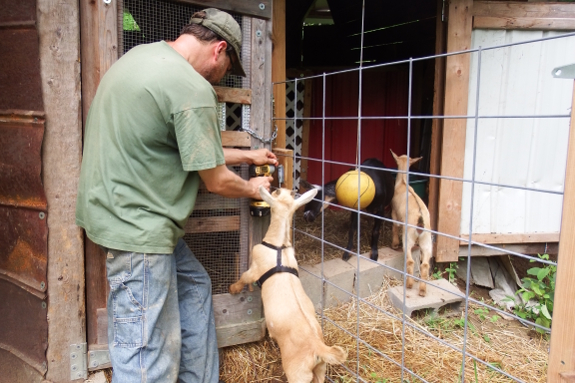
The bad news? Between
Punkin calling "Mama!" and Artemesia hollering "My baby!" relentlessly
on day one, our mile-distant neighbor became convinced Mark was guilty
of spousal abuse. The neighbor in question came over on his
four-wheeler with a pistol at his hip the next day to check on
us...which was actually pretty sweet, in my opinion.
Unfortunately, I
wasn't able to run over to check on the visitor the way I usually do
because I was knee deep in the bee hives, so I left the guys talking
for about ten minutes before showing up. I hope our neighbor believed that
no one was being murdered over here and we simply have a couple of
unruly goats...but I guess we'll see if Mark's been kicked out of the
good-old-boy network or not.
(Yes, this is the
equivalent of calling the cops when you live in the country.)
We took Aurora back to the vet this morning for another check up.
She'll get fed a mixture of yogurt and her mother's milk until she starts feeling better and eating on her own.
We also got some take home shots for tomorrow and the next day.
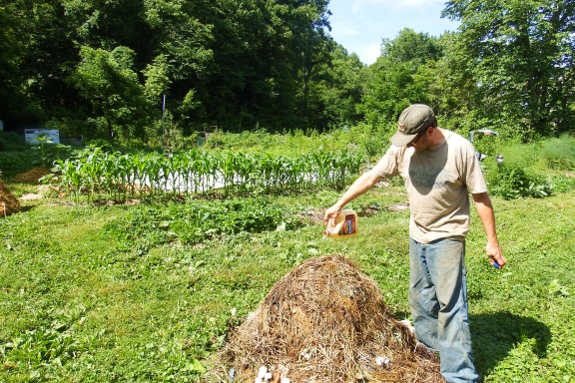
All of my reveling in off-farm
manure aside, one of
my big goals for the next few years is to close our homestead's
fertility loop. As the heaviest amendment, I'm working on compost
first, although mulch will likely go on my game plan eventually.
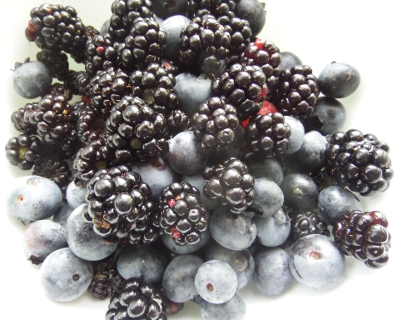 To that end, we're being much
more frugal than we have been in the past about making sure every
little bit of nitrogen ends up back in the garden. Urine is definitely
the low-hanging fruit and I'm always thrilled when I see Mark
"nitrogenate the compost pile" (as he calls it).
To that end, we're being much
more frugal than we have been in the past about making sure every
little bit of nitrogen ends up back in the garden. Urine is definitely
the low-hanging fruit and I'm always thrilled when I see Mark
"nitrogenate the compost pile" (as he calls it).
If you want to learn
more about our fertility sources so far, check out Soil
Amendments for the Organic Garden, which is up for preorder
and will be hitting kindles in three weeks. Enjoy!
Anna noticed the first signs of blight on some tomato leaves today.
Arghhhhh!
We might try a propane weed burner next year to see if it has an impact on the size of the blight spore population.
Want more in-depth information? Browse through our books.
Or explore more posts by date or by subject.
About us: Anna Hess and Mark Hamilton spent over a decade living self-sufficiently in the mountains of Virginia before moving north to start over from scratch in the foothills of Ohio. They've experimented with permaculture, no-till gardening, trailersteading, home-based microbusinesses and much more, writing about their adventures in both blogs and books.
